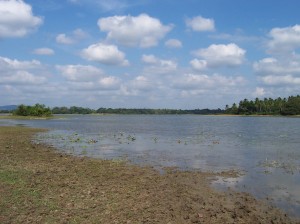Sri Lanka is only just emerging from a year-long drought that has wreaked havoc on the lives of around 10% of the population (link DMC situational report, 25 Sep). It destroyed over 80,000 hectares of paddy, accounting for about 15% of the paddy production forecasted for the entire year (2014)
Rice production directly affects the country’s food security. Over one-third of Sri Lanka’s labor force derives its income from heavily weather-dependent agriculture.

Photo: Arosha Ranasighe/ IWMI
The situation could worsen. According to a recent report published by the Ministry of Environment and Renewable Energy of Sri Lanka, “droughts and unpredictable rainfall regimes already experienced in the Dry Zone are expected to become more prolonged and unpredictable”.
Up to now, lack of data and information sharing has prevented Sri Lanka from taking measures against extreme weather events. However, natural disasters need not be bolts from the blue much longer. A state-of-the-art drought monitoring tool is being developed by the International Water Management Institute (IWMI) and partners will help Sri Lanka to know, well in advance, what to expect with the weather and provide water users with time to prepare for dry spells.
The tool, known as the South Asia Drought Monitoring System (SA-DMS), is being developed for use by all South Asian countries and will be ready to be launched next year. It uses satellite images of vegetation and forest cover, and information on the weather, soil moisture levels and crop yields, and compares current readings with historical data to predict the severity and duration of upcoming dry spells.
SA-DMS, designed by IWMI, will be jointly implemented together with Global Water Partnership (GWP) and the World Meteorological Organization (WMO). It is supported by the governments of Sri Lanka, Afghanistan, Bhutan, Bangladesh, Maldives, Nepal, India and Pakistan. The tool builds on work carried out by IWMI in 2004, which showed the use of remote sensing data for near-real time monitoring of the onset of drought, its progression and spatial extent.
However, the tool’s success in averting the consequences of future extreme weather events will depend on how fast the real-time updates reach end-users. “The obligations we have as developers of the system are to ensure the data are updated and processed as quickly as possible,” said Vladimir Smakhtin, Theme Leader – Water Availability, Risk and Resilience, IWMI. We also have to ensure there is a reliable system for disseminating the findings to policymakers, the media and farmer organizations in good time.”
Scientists recognize that natural disasters are becoming increasingly endemic to Asia and that predicting them is essential for the region’s economic well-being. ”Just one disaster caused either by too little or too much rain could wipe out many years of a country’s progress,” said Herath Manthrithilake, Head, Sri Lanka Development Initiative, IWMI.
“As well as affecting harvests, rising temperatures and more frequent and severe droughts will likely worsen existing competition for water resources,” said Giriraj Amarnath, Researcher – Remote Sensing and Water Resources, IWMI. “SA-DMS uses all the crucial indicators of impending drought which, when combined, give the clearest idea possible of where a drought could strike and how severe it might be. It means users get advance warning, thereby giving them precious time to react and adapt to the likelihood of a difficult situation.”
Information provided by the new tool could help farmers adjust crop cycles to accommodate volatile weather. The vital paddy farming sector follows the traditional cycle of planting and harvesting based on the two northeast and the southwest monsoons, which have become increasingly erratic over the past 3 years.

